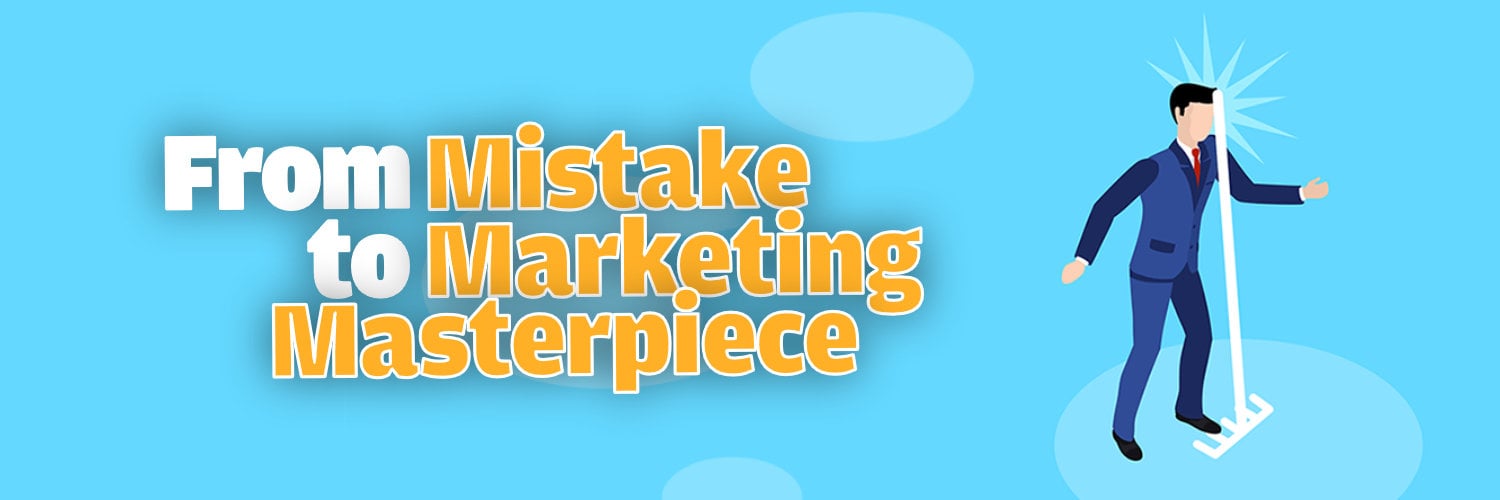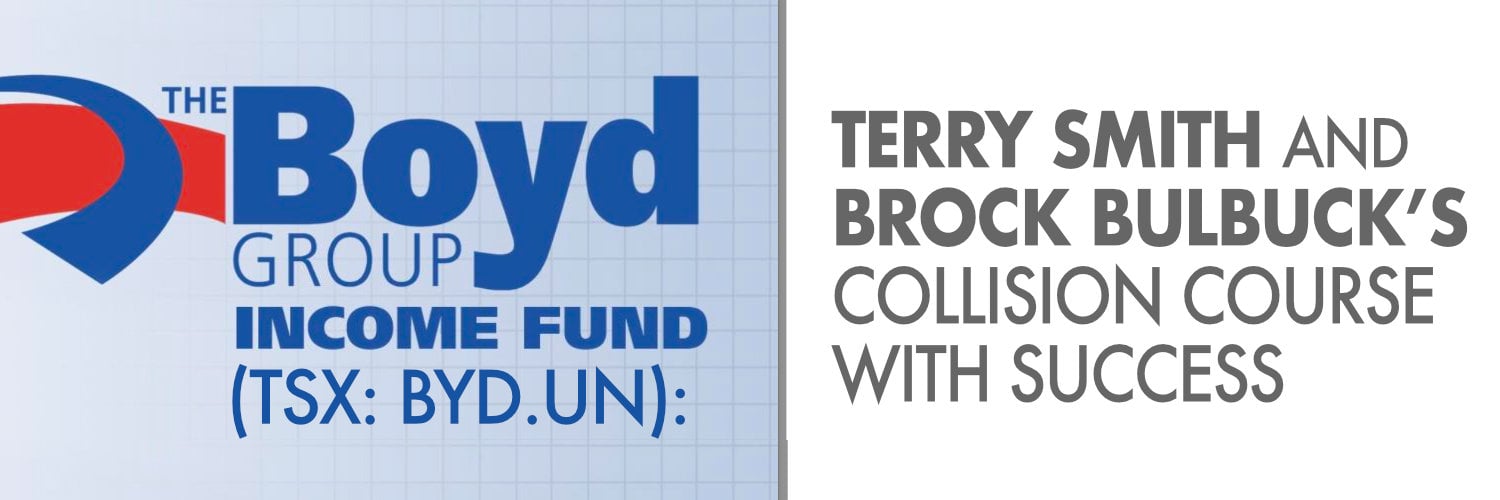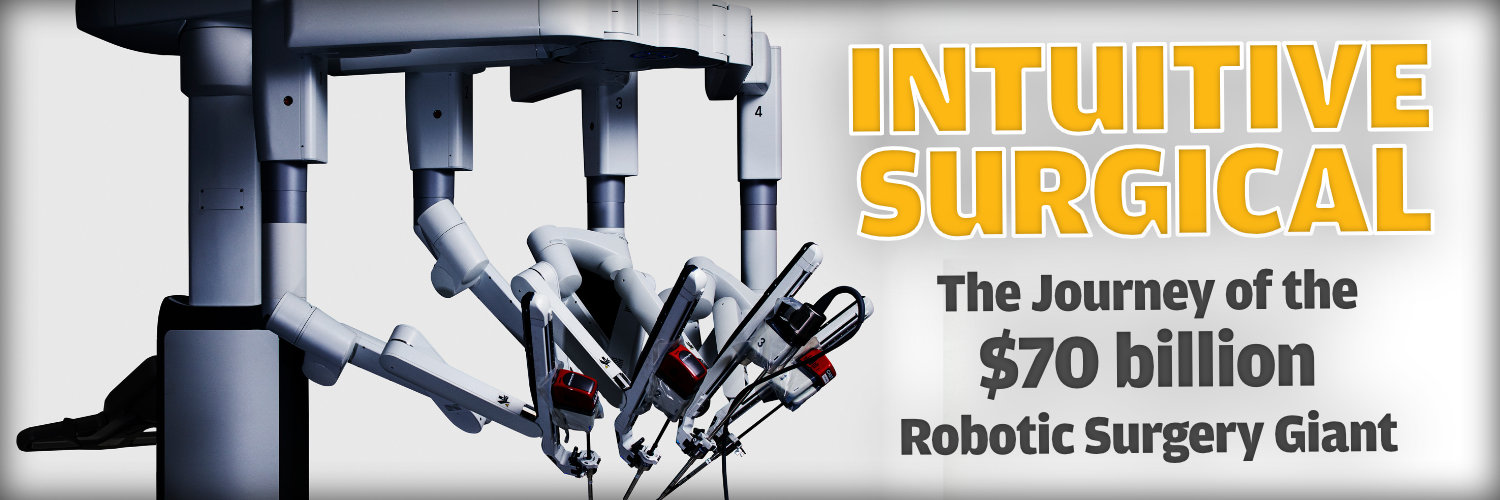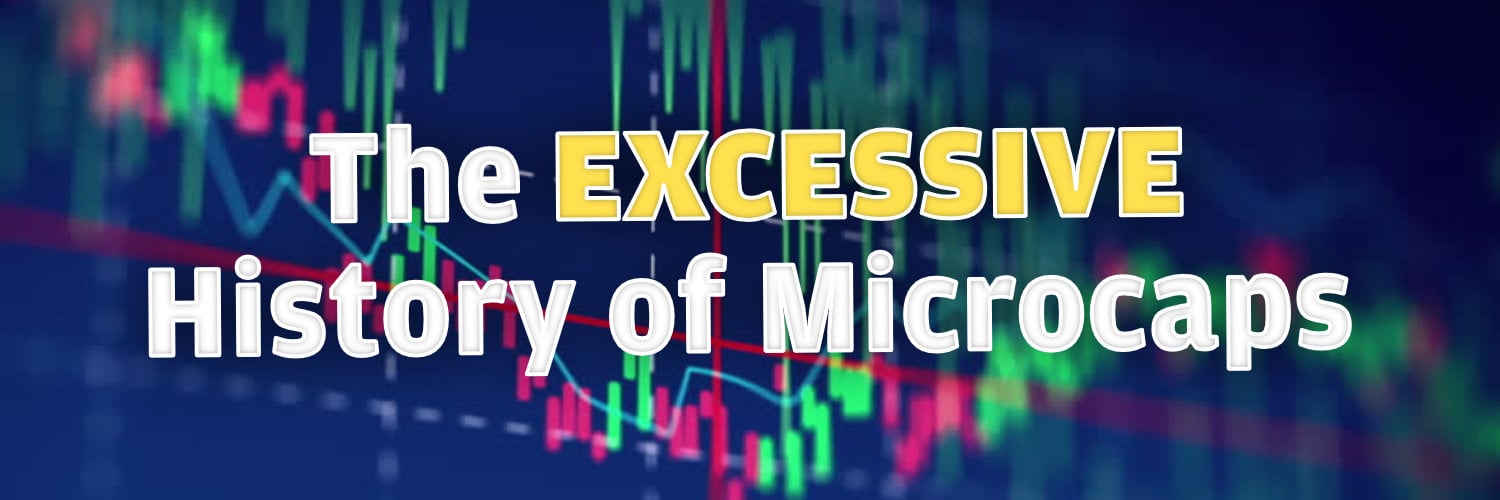
From Mistake to Marketing Masterpiece
There has been much discussion on how Coca-Cola became so dominant. Could it be that it was all from a mistake?
The Boyd Group trades under the name, Boyd Group Income Fund (TSX:BYD.UN), and is the best performing stock in Canada over the last 10 years.

In 1990, Terry Smith at age 37, purchased a single location collision repair business called Boyd Autobody in Winnipeg, Manitoba. Over the next few years he would acquire several other locations and in 1998 publicly list the company on the Winnepeg Stock Exchange as the first publicly traded collision-repair business in North America. Today, Boyd Group operates ~400 collision repair centers across North America in addition to overseeing thousands of affiliated retail-glass and emergency road side service locations. The Boyd Group trades under the name, Boyd Group Income Fund (TSX:BYD.UN), and is the best performing stock in Canada over the last 10 years.
In 2006, Boyd Group was a $1 per share, $10 million market cap microcap, and today it is a $84 per share $1.5 billion market cap smallcap. Shareholders that were lucky and skillful enough to buy and hold Boyd Group during this ten-year period have realized a veracious 55.7% CAGR (80-Bagger). We will now take a deeper dive into the story of Boyd Group and its intelligent fanatic founder Terry Smith, and his long-time business partner (now CEO) Brock Bulbuck.
Terry Smith was an investor at a young age having invested in a restaurant chain called Clancy’s. Smith likely learned the art of risk taking from his father. At the age of 62, Terry Smith’s father sold his house in Vancouver to go into business. The business was Docksteader Collision Centre. Terry would invest alongside his father in this venture. He studied the business and liked what he saw. With over 1,200 autobody shops in Manitoba alone, he saw a consolidation opportunity. He also liked the payer dynamic since insurance companies were the payer in 75%+ of repair cases.
He needed money to take advantage of this opportunity, so he formed Cross Canada Collision Centres Limited Partnership to raise capital. Terry was the consummate salesman and had no issues raising money. Due to Manitoba Security Commission rules he had 180 days to raise capital, and he successfully raised $1.5 million (150 units at $10,000 each). Over a subsequent 180-day period, he raised an additional $1.5 million. All in, Terry Smith was able to raise $4 million for Cross Canada Collision Centres Limited Partnership from 325 limited partners. He now had a war chest of cash to execute his grand vision of becoming of a dominant multi-shop collision repair operator (MSO). On November 1st, 1990, after six months of negotiation he paid $100,000 for Boyd Autobody. He now had his first repair center, and it wouldn’t be the last.
By 1993, Terry Smith acquired and managed six collision centers in Manitoba which produced ~$6 million in combined revenues. Just like many intelligent fanatics, Terry Smith had very little industry experience, so he approached the business differently. He wanted to have clean and presentable operations to attract, market, and keep customers. In a 1993 interview, Smith stated:
“My competitors don’t understand. We’re running this business like a retail operation, not a blacksmith shop, which is the original roots of the autobody repair business. We want clean surroundings in high traffic areas. That’s our marketing strategy.”
Similar to Wal-Mart or Home Depot, one of the key benefits of being a multi-shop operator (MSO) is the ability to pool advertising and marketing dollars to build a brand that is front and center in consumers minds. In an interview in 2000, Smith provided an example to illustrate this:
“…the Winnepeg market, where Boyd began, has a population of about 600,000 and where we have 10 locations. Those locations contribute approximately $500,000 per year in brand building, marketing, and advertising initiatives. Our next largest competitor spends $50,000.”
Good service, clean locations, and effective mass marketing created a perfect recipe for happy customers and growth. In fact, roughly half of Boyd’s new customers in the mid-late 1990’s came from customer referrals. The company also found they could add significant value to acquired locations by providing diligent financial management, strategic planning, and bulk purchasing.
In January 1993, Terry’s long-time friend Brock Bulbuck joined the company to help him expand operations. Brock would be Terry’s right hand man taking on a variety of roles including: Vice President, Senior Vice President, CFO, President & COO, and finally taking over as CEO in 2010. Smith said this of his close friend and business partner, “He is a man of the highest integrity and the smartest man I have ever met”.
By 1995, Boyd Group had 12 locations (up from 6 in 1993). The company continued to expand opening additional collision centers in Manitoba and British Columbia. The acquisition strategy was quite simple, “We look for collision repair shops that are leaders in their markets, have strong and consistent earning power, and possess quality, well- respected management personnel.”
In 1997, The Boyd Group Inc. was formed to acquire the Limited Partnership to facilitate a public stock exchange listing. On February 9, 1998, approximately 6.1 million shares were listed on the Winnipeg Stock Exchange and Boyd Group became the first and only publicly traded collision repair company in North America. [In 1999, the company would upgrade its listing to the Toronto Stock Exchange]. The company raised an additional $4.5 million of growth capital, and by the end of 1998 the company had 32 locations, including its first locations in the United States.
Most intelligent fanatics look to run decentralized organizations that decrease management layers and increase employee autonomy. Companies with strong leadership that focus on maintaining a culture will win in the long-term. In 1995, 1996, and 1997, Boyd Group was recognized by the Financial Post and Arthur Anderson as one of Canada’s 50 best managed companies.
In Boyd Group’s first annual report as a public company there are big bold letters, “PEOPLE ARE OUR STRENGTH” and under this title, “People are now, and will continue to be, our strength. Commitment to, and from all our employees will always be one of our top priorities. We are constantly challenged to provide an environment which allows us to attract, develop, and keep quality people.”
In 2000, Boyd Group would define its culture and values as having four cornerstones:
Other differentiating factors that set Boyd Group apart from the everyday Mom and Pop autobody shops was Terry Smith and Brock Bulbuck’s relentless dedication to customer service and quality control. Boyd Group hired an external firm to set up Customer Satisfaction Indexing (CSI), a mechanism to randomly survey customers and provide an assessment to managers. Store managers and senior management were compensated based in part on the basis of their CSI performance.
In 1999, Boyd’s King Edward location in Winnipeg was the first collision repair center in North America to earn ISO 9002 registration. The company then developed plans to introduce and develop the ISO program in all of its locations and by the end of 2000, 32 locations achieved ISO 9002 certification. Around this same time the company launched its Common Branding Strategy to rename acquired units to achieve the benefits of having one common name.
In Greek mythology, the Sirens were dangerous mermaid like creatures whose seductive music would lure sailors to their doom. Terry Smith was not immune to the siren song of growth. In 2000, when the company was on a $100 million revenue run rate, Terry Smith made a bold projection. He proclaimed that the company would hit $500 million in sales and $1 per share in earnings by 2004. He was wrong.
In addition, in 2002, the board evaluated converting the company into an income fund for tax purposes. In 2003, shareholder approved the conversion renaming the parent company Boyd Group Income Fund and sold 1 million trust units in an IPO on the Toronto Stock Exchange. The fund would make monthly cash distributions to the “maximum extent possible”.
In the early 2000’s, expansion into the US proved harder than previously thought and they had to shut down a few locations due to lack of performance. The United States was still a huge opportunity for Boyd Group. They just needed to attack it differently. Instead of buying single units, they decided to focus on acquiring a larger best in class collision repair chain. In February 2004, they acquired Gerber Group and its 16 repair facilities in the greater Chicago area. Gerber Group was a large acquisition at roughly half the size of Boyd Group. Boyd would then rebrand all their remaining US locations under this one brand, Gerber Collision & Glass.
During this time, the North American auto collision repair industry was weakening, and combined with a strong Canadian dollar, the effects were seen in Boyd Group’s financial performance. The company funded its acquisition strategy mainly through a credit facility and stock issuances. Financial performance was lagging and the company was paying out a bulk of its operating cash flow in monthly distributions.
In early 2005 the company started reducing the monthly distributions and by late 2005 the board made the hard decision to temporarily suspend monthly distributions. In 2006 they took a $17.8 million non-cash write down of goodwill. Investors punished the stock below $1 per share.
In 2007, the macro and currency headwinds started to neutralize and the hard, laborious work put into the US strategy started to show in the financials. US same store sales were up almost 6% in 2007. Insurance companies also stepped up giving Boyd commitments of $7.5 – 20 million per year of additional business. The company paid down more debt, and by YE 2007 they reinstituted a sustainable monthly distribution. The board would modify the distribution based on current and prospective performance of the business with the goal of increasing it over time.
Boyd Group’s business continued to grow right through the financial crisis of 2008, and since few institutions really owned the stock, the stock went up 8% for the year. [Authors Note: Coincidentally I had a similar experience as an investor in 2008. What I’ve found is when you own a great business that no one owns it only has one way to go, Up.]
Great allocators know when to use their stock as currency and when to eat themselves. With the stock at all-time lows and the business turning positive, it was time to eat themselves. On October 15, 2007, the company announced a Normal Course Issuer Bid (Canadian for “Buy Back”) and bought back 90,900 shares ($2.60 average price) in 2007, 565,900 shares ($2.72 average price) in 2008, 338,000 shares ($3.50 average price) in 2009. From October 2007 to December 2009, the company repurchased ~9% of their outstanding shares.
In 2009, Terry Smith was seriously injured in a snowmobile accident, and it immobilized him for six months. In his absence, Brock Bulbuck and management stepped in and the company didn’t skip a beat. When Terry finally recovered, he felt it was time to hand over the reins, so in January of 2010, Terry Smith stepped down as CEO, and Brock Bulbuck stepped in.
From 2006 until mid-2010 the company made no large MSO acquisitions, opening 6-8-10 new locations per year under the Gerber and Boyd brands.
Brock Bulbuck and the board had been waiting patiently to make larger MSO acquisitions. The time had come. Here is a list of their larger MSO acquisitions from Mid-2010 to Present:
The amount of large MSO acquisitions above may seem aggressive, but Boyd Group is very strategic and disciplined in their strategy. Boyd won’t acquire MSOs if they don’t meet certain return hurdle rates. So in periods of high deal competition, like in 2015 and 2016, you won’t see Boyd acquire many large MSOs. In fact they adapted their strategy the last couple years to be able to do more single shop acquisitions where there is almost never any deal competition. They will usually do a large acquisition to enter a new territory, then they will add single locations around that area. They usually spend around $500,000 for single locations and make 25% EBITDA ROIC after a 12-24-month period where they get revenue synergies from insurers that redirect traffic to their newly acquired location and also from productivity enhancement.
If you can reduce repair cycle times you can increase productivity, customer satisfaction, and same store sales growth. The US industry average repair cycle time for MSO’s is 10.5 – 12 days. Boyd was averaging 2 days faster than the average, but they weren’t happy with this. Starting in 2013, Boyd spent 18 months and $3.5 million working with consultants developing a system to reduce their repair cycle times to 5-7 days. They called the system the “WOW Operating Way”. The company has been slowly implementing the WOW Operating Way across all its facilities.
In 2010, the tax advantages of being organized as a Fund extinguished. The board evaluated a reorganization into a corporation, but after a thorough investigation they concluded it was in the unit holders best interest to remain a Fund. Boyd Group has consistently increased its monthly distributions to unitholders.
In 1990, Terry Smith had a vision of becoming a dominant MSO in North America. He succeeded with the help of Brock Bulbuck and many other capable managers and employees. The company’s success has attracted other financial institutions to the MSO consolidation story. There are four big consolidators. Boyd is one, and the other three are owned by private equity funds.
Today, Boyd Group is still the only public company in the auto collision repair industry. Perhaps the most interesting thing is Boyd Group only has a 3.7% market share of its addressable market, and the most exciting thing is Boyd Group is still a relatively small $1.5 billion market cap smallcap. In late 2015, the company announced they expect to double their revenues in five years (implied 15% growth).
If you look at Boyd Group’s stock chart in the beginning of the article (2006 – Present), it’s easy to assume the company’s success was immediate, obvious, with linear up and to the right results. But reality kicks in when you view the previous eight years (1998-2006) of hardship. It is tremendously difficult to scale a business from nothing to $1 billion in revenues without growing pains along the way. A commonality in all intelligent fanatics and great companies is perseverance. Almost all successful people and companies at some point went through incredible hardship, obstacles, and challenges. The power to endure is the winner’s quality. If you enjoyed this article, I know you will enjoy reading our new book: The Intelligent Fanatics Project: How Great Leaders Build Sustainable Businesses.
*I want to thank a couple of our members, who wish to remain anonymous, for helping me write this article.
In addition to SEDAR filings, I used the following sources for quotes and information:
Our MicroCapClub Members [Join Us]
Collision kingpin: Terry Smith collides with success
TWST Interview with Terry Smith
Raymond James Boyd Group Initiation Report
Boyd Group founder handing over the reins
Boyd Group Income Fund Investor Presentation
Collision M&A Consolidation Trends Update
If you enjoyed this article on Boyd Group, you will also enjoy reading these articles:
Patrick Industries (PATK): The Best Performing Stock Since 2009
Bank of the Ozarks (OZRK): The Story of Intelligent Fanatic George Gleason
DaVita HealthCare Partners (DVA): An Intelligent Fanatic Led Turn Around
Middleby Corporation (MIDD): Case Study of an Intelligent Fanatic Led 100-Bagger
MTY Food Group – A Case Study of a 100-Bagger
===> Interact and learn with 250+ of the best microcap investors on the planet. [Join Us]
MicroCapClub is an exclusive forum for experienced microcap investors focused on microcap companies (sub $500m market cap) trading on United States, Canadian, European, and Australian markets. MicroCapClub was created to be a platform for experienced microcap investors to share and discuss stock ideas. Since 2011, our members have profiled 1000+ microcap companies. Investors can join our community by applying to become a member or subscribing to gain instant view only access. MicroCapClub’s mission is to foster the highest quality microcap investor Community, produce Educational content for investors, and promote better Leadership in the microcap arena. For more information, visit http://microcapclub.com and https://microcapclub.com/summit/
Get Alerted to our Next Educational Blog Post

There has been much discussion on how Coca-Cola became so dominant. Could it be that it was all from a mistake?

In 2000, Intuitive surgical raised $46 million in its IPO. In 2001, ISRG hit a low of $131 million market cap, and today is a $70 billion market cap. ISRG stock has risen 9,800% since its IPO.

An alternative lesson to draw from his study is that microcaps are fine but nanocaps are the ticket to wealth; you just have to be poor enough to buy them.